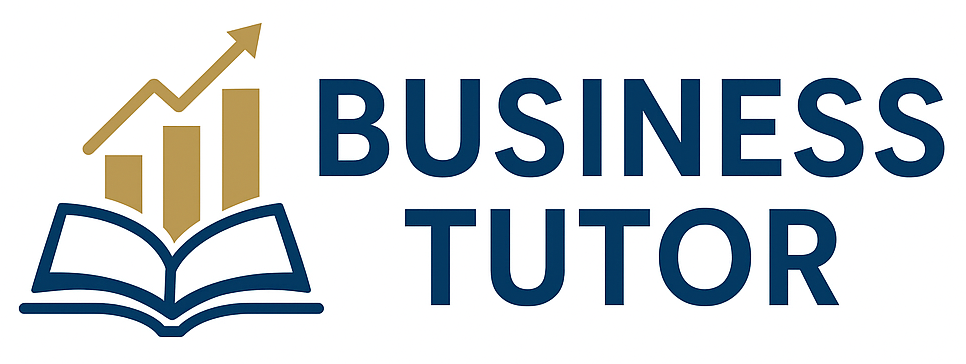When studying A-Level Business, one of the biggest challenges is remembering the various formulas and models you’ll need for the exams. From profit calculations to financial ratios, understanding how and when to apply these formulas is crucial for achieving top marks. But don’t worry, it’s entirely possible to memorise them and, more importantly, understand their application.
In this post, we’ll go over some effective strategies for remembering formulas and business models, so you can tackle your exams with confidence.
1. Understand the Concepts Behind the Formulas
Simply memorising formulas without understanding the concepts behind them won’t do you much good in an exam setting. It’s essential to understand the “why” before focusing on the “how”. When you truly understand a formula’s purpose, it becomes easier to remember and apply.
2. Use Mnemonics and Acronym
Mnemonics and acronyms are great tools for memorising formulas and models. They create a link between the formula and something more memorable.
Example:
For models, you can create acronyms to help you remember the key components. For instance, the SWOT Analysis (Strengths, Weaknesses, Opportunities, Threats) can be remembered with the phrase “Some Weaknesses Only Threaten.”
3. Create Flashcards
Flashcards are a fantastic way to reinforce your memory. Write the formula or model on one side and the explanation or an example on the other. Reviewing them regularly will help solidify your knowledge.
Tips for effective flashcards:
- Keep them simple: Just the key points or steps, not an entire paragraph.
- Colour-code: Use colours to highlight different sections (e.g., one colour for the formula, another for the meaning).
- Review regularly: Spaced repetition is key—review flashcards daily or weekly to help reinforce your memory.
4. Practice, Practice, Practice
There’s no substitute for practice. The more you apply formulas and models to real-world scenarios, the easier it will be to recall them during the exam.
How to practice:
- Past papers: The more past papers you work through, the more familiar you will become with applying the formulas in exam conditions.
- Mock exams: Simulate exam conditions at home to test yourself on the formulas and models you’ve learned.
- Practice questions: Ask your teachers or use textbooks to find questions specifically focusing on applying formulas.
5. Use Visual Aids and Mind Maps
Many students find that visualising the relationships between different formulas and models helps them retain information better. Try creating mind maps or diagrams that connect related concepts.
Example:
For the 4 Ps of Marketing (Product, Price, Place, Promotion), you could create a mind map where each “P” links to a real-world example or a key detail about how it works in business. This method turns abstract concepts into something concrete and memorable.
6. Group Study Sessions
Studying with friends can be a great way to reinforce what you’ve learned. You can quiz each other on formulas, explain models to one another, and share tips for memorising. Teaching someone else is one of the most effective ways to strengthen your understanding and memory.
Group study tips:
- Take turns: Quiz each other on specific formulas or business models.
- Teach a friend: Explaining a concept out loud helps reinforce your own understanding.
- Keep it focused: Make sure each study session has a specific focus, such as “this session, we’ll focus on financial ratios”.
7. Relate Formulas and Models to Real-World Examples
Linking formulas and models to real-life businesses and scenarios makes them easier to remember. When you can picture how a formula or model works in practice, you are more likely to retain it.
Example:
- Price Elasticity of Demand (PED): Think about how businesses change prices for products. If a company increases the price of a luxury item, the demand might drop sharply (high elasticity), whereas for a necessity (like bread or milk), demand is less affected (low elasticity). By connecting the theory to real businesses, the concept sticks better in your mind.
8. Break it Down into Smaller Chunks
Instead of trying to remember a whole list of formulas or models at once, break them down into smaller groups. For example, focus on financial formulas one week, and marketing models the next. Spacing out your revision sessions for each category will make it less overwhelming.
Final Thoughts
Remember, formulas and models are crucial for A-Level Business, but they don’t need to be a source of stress. The key is to understand the concepts, practice consistently, and find revision techniques that work for you. Using mnemonics, flashcards, and group study sessions can make remembering formulas much easier, and applying them in real-world scenarios will strengthen your understanding.
With regular practice, organisation, and a bit of creativity, you’ll have no problem recalling the key formulas and models when it matters most, on exam day.
Good luck with your revision, and remember to keep calm and carry on!

